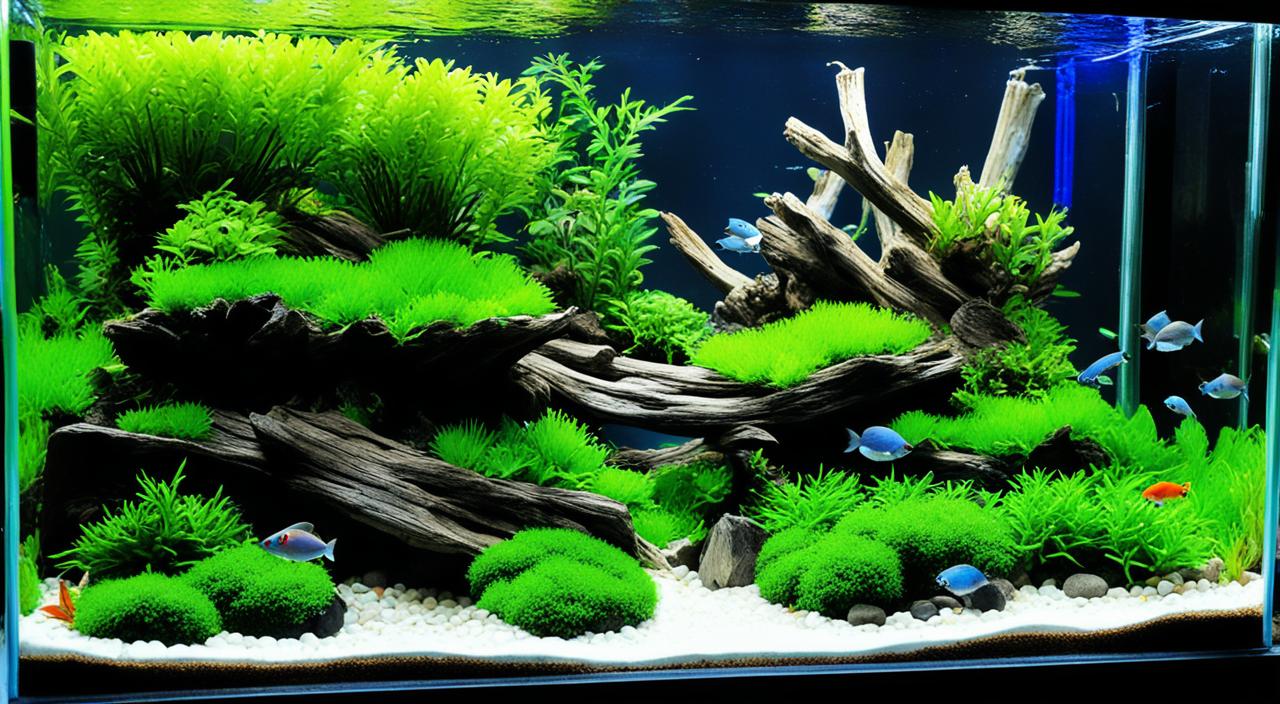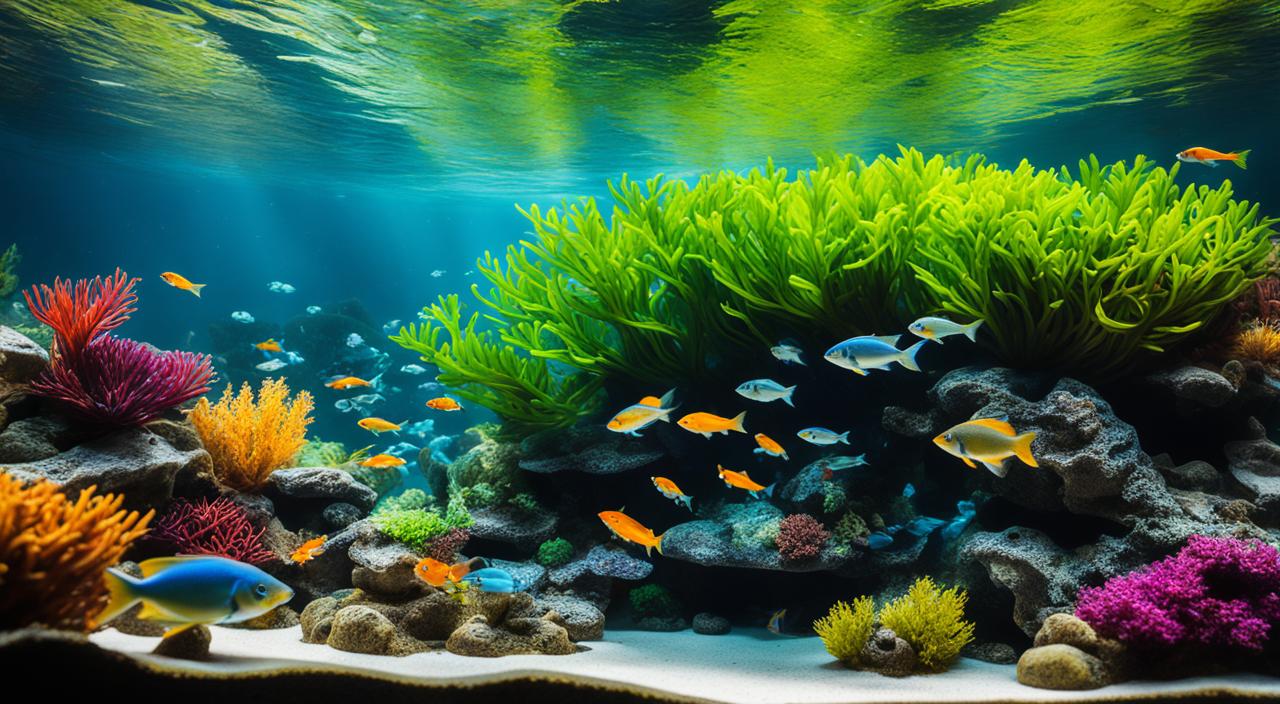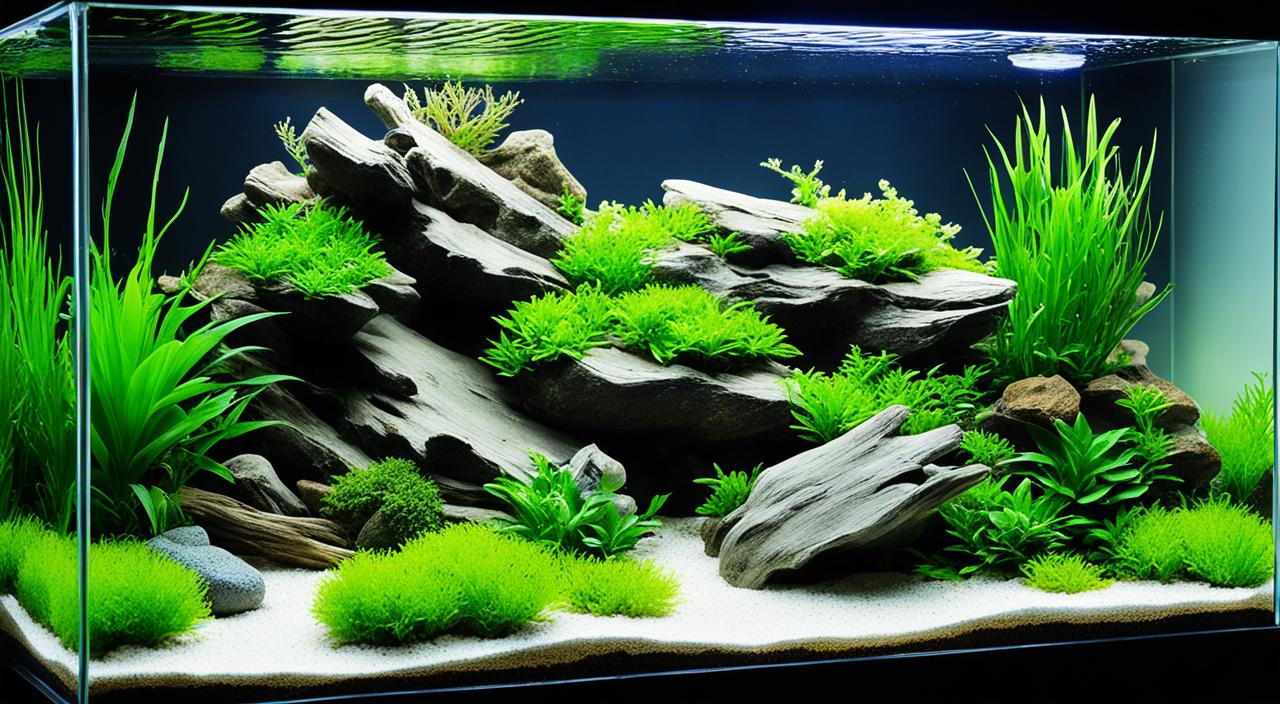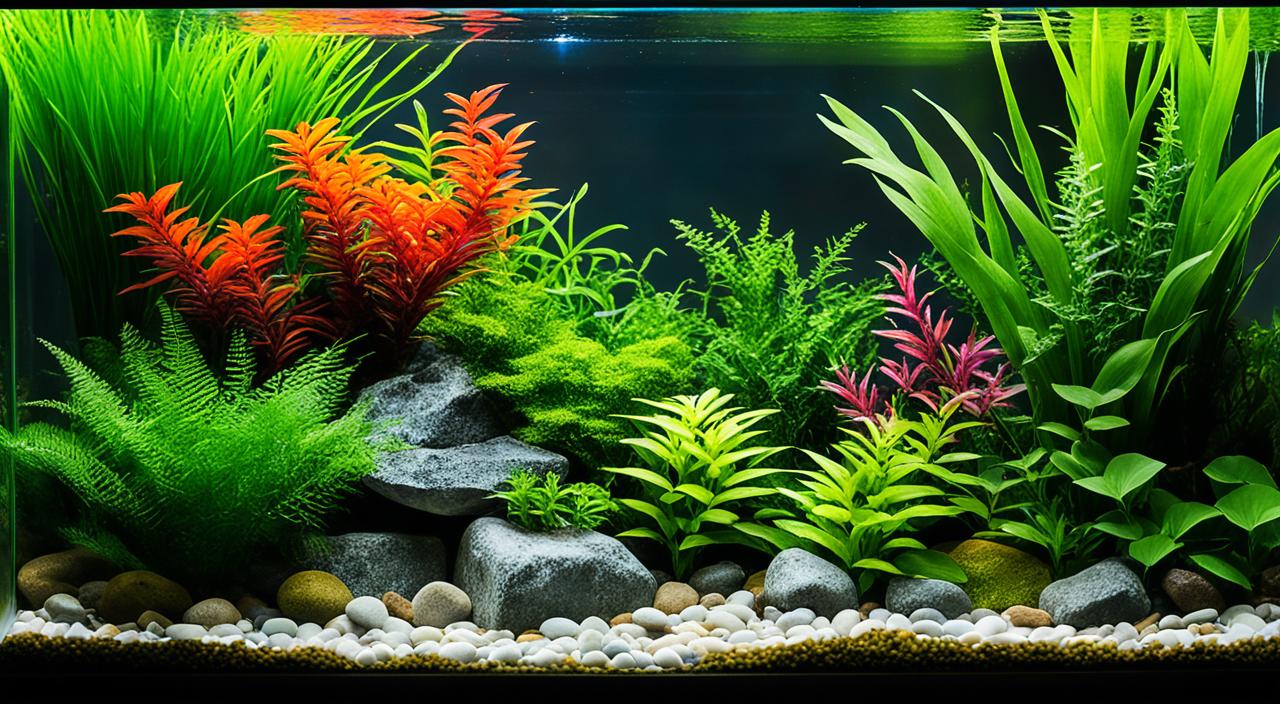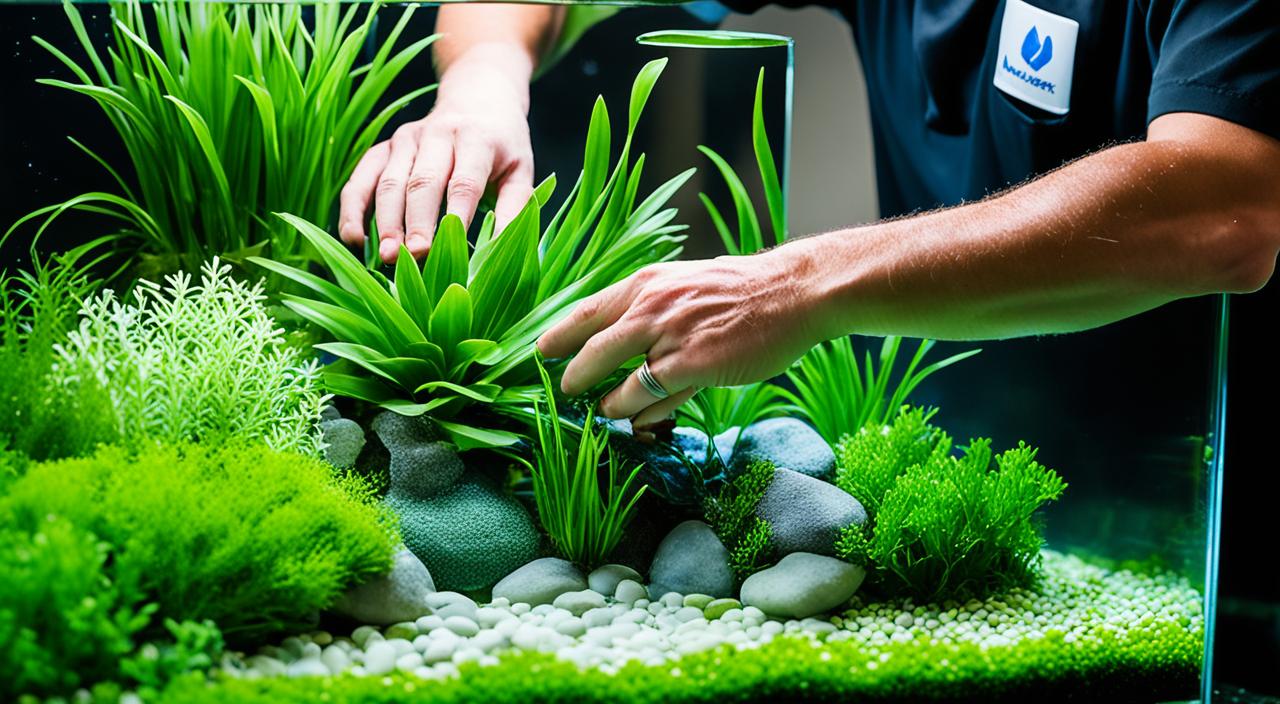Aquascaping is the art of building underwater landscapes in an aquarium. It involves arranging stones, wood (hardscape), and plants (softscape) to create an underwater miniature scene. Aquascaping has gained popularity due to its decorative and visually appealing nature. It requires time and commitment for maintenance, as well as a long-term spot and patience for the plants to grow. The essential components required for aquascaping include an aquarium, water filter, light source, CO2 system, substrate, and aquatic plants. Investing in the right equipment and understanding the basics before starting an aquascape is essential.
Key Takeaways:
- Aquascaping involves creating underwater landscapes in an aquarium.
- It requires arranging stones, wood, and plants to create a visually appealing scene.
- The basic components for aquascaping include an aquarium, water filter, light source, CO2 system, substrate, and aquatic plants.
- Aquascaping requires time, commitment, and patience for the plants to grow.
- Investing in the right equipment and understanding the basics is essential for a successful aquascape.
The Components of Aquascaping
When it comes to aquascaping, several key components play a crucial role in creating a successful and visually stunning aquarium. These components include the aquarium itself, filtration options, lighting requirements, CO2 system setup, substrate types, and a wide variety of aquatic plants.
Let’s take a closer look at each of these components:
Aquarium Setup
The first and foremost component of aquascaping is the aquarium. It serves as the canvas for your underwater masterpiece. Choosing the right size and type of aquarium is essential to provide the necessary space for the plants to thrive and the fish to swim comfortably.
Filtration Options
A proper filtration system is necessary to maintain water quality and ensure the overall health of your aquascape. There are various filtration options available, including mechanical, chemical, and biological filtration. Each option performs a specific function to remove waste, toxins, and harmful substances from the water.
Lighting Requirements
Lighting plays a vital role in plant growth and photosynthesis. It is important to select the right lighting system that provides the necessary spectrum and intensity for your aquatic plants. Different plants have different lighting requirements, so it is crucial to research and choose suitable lighting options accordingly.
CO2 System Setup
Carbon dioxide (CO2) supplementation is often essential for healthy plant growth in an aquascape. A CO2 system helps to provide the necessary carbon source for plant photosynthesis and promote lush, vibrant growth. There are various CO2 system setups available, such as diffusers and injection systems, depending on the size and complexity of your aquascape.
Substrate Types
The substrate in an aquascape serves as a foundation for plant rooting and nutrient absorption. It also provides stability for hardscape elements. Different substrate types offer varying benefits, including nutrient-rich substrates for demanding plants and inert substrates for low-maintenance setups. It is important to choose the right substrate based on the specific needs of your aquatic plants.
Aquatic Plants
The selection of aquatic plants is crucial for achieving a visually pleasing and balanced aquascape. Different plants have different growth habits, colors, and requirements. It is essential to choose a variety of plants that complement each other and create a harmonious underwater environment.
Component Comparison
| Component | Description |
|---|---|
| Aquarium Setup | Provides the foundation for the aquascape and determines the available space for plants and fish. |
| Filtration Options | Maintains water quality by removing waste and harmful substances from the aquarium. |
| Lighting Requirements | Provides the necessary light spectrum and intensity for healthy plant growth. |
| CO2 System Setup | Supplements carbon dioxide for plant photosynthesis and vibrant growth. |
| Substrate Types | Provides a foundation for plant rooting and nutrient absorption. |
| Aquatic Plants | Selection of plants that create a visually pleasing and balanced aquascape. |
Setting Up the Aquarium
When it comes to aquascaping, setting up the aquarium properly is crucial. This involves considering water chemistry basics, establishing a maintenance routine, selecting the right aquarium decorations, and having the necessary aquascaping tools. Let’s dive into each of these important aspects.
Water Chemistry Basics
Before adding any fish or plants to your aquarium, it’s essential to ensure proper water chemistry. Start by dechlorinating the water to remove any harmful chemicals. Additionally, regularly test the water quality for parameters such as pH, ammonia, and nitrate levels to maintain a conducive environment for your aquatic pets and plants.
Maintenance Routine
Maintaining your aquascape requires a consistent routine. Regularly cleaning the aquarium, trimming plants, and changing the water are vital tasks that help keep the ecosystem healthy and thriving. Implementing a maintenance routine will prevent the buildup of algae and other unwanted substances, ensuring a clean and beautiful aquascape.
Aquarium Decoration
Aquarium decoration plays a significant role in the overall aesthetics of your aquascape. Choose suitable aquarium decorations that complement the theme and style you’re aiming for. Incorporating elements such as rocks, driftwood, and live plants can create a visually stunning underwater landscape. Be mindful of the size and placement of your decorations to maintain a balanced and harmonious aquascape.
Aquascaping Tools
Aquascaping tools are essential for maintaining and creating your aquascape. Scissors and tweezers are invaluable for trimming and planting aquatic plants accurately. They allow for precise shaping and placement, ensuring the desired visual effect. Invest in high-quality aquascaping tools to make your aquascape maintenance tasks more efficient and enjoyable.
| Essential Aquascaping Tools | Description |
|---|---|
| Scissors | Used for trimming aquatic plants, removing dead leaves, and shaping plant formations. |
| Tweezers | Allow for precise planting of delicate aquatic plants and rearranging decorations. |
| Algae Scraper/Magnet | Helps remove algae from the aquarium glass, keeping it clean and clear. |
| Siphon/Gravel Vacuum | Used for regular water changes and cleaning the substrate, removing debris and accumulated waste. |
By taking care in setting up your aquarium, considering water chemistry basics, following a maintenance routine, selecting the right decorations, and utilizing the necessary aquascaping tools, you’ll be on your way to creating a stunning aquascape that brings beauty and tranquility to your space.
Achieving a Balanced Aquascape
Creating a visually balanced aquascape is essential to bring out the true beauty of your underwater world. By applying design principles, considering fish compatibility, nutrient dosing, and implementing effective algae prevention methods, you can create a harmonious and thriving aquatic environment.
Design Principles
When designing your aquascape, it is important to follow design principles such as the rule of thirds and the golden ratio. These principles help create visually pleasing compositions and guide your placement of hardscape elements, plants, and focal points within the aquarium.
Fish Compatibility
While designing your aquascape, it is crucial to consider the compatibility of fish species with the plants and overall design. Some fish may uproot plants or disturb the layout, which can disrupt the balance of your aquascape. Researching and selecting fish species that are suitable for planted aquariums will help maintain the integrity of your design.
Nutrient Dosing
Proper nutrient dosing is vital for healthy plant growth in your aquascape. Adding fertilizers and providing a suitable CO2 system will ensure that your plants receive the necessary nutrients for optimal development. Regularly monitoring nutrient levels and adjusting dosing accordingly is essential for maintaining a balanced and thriving aquascape.
Algae Prevention
Algae can be a common issue in aquariums, jeopardizing the aesthetics and overall health of your aquascape. To prevent algae growth, it is important to maintain water quality by regularly testing and monitoring parameters. Implementing a suitable lighting schedule and considering factors such as water flow and nutrient levels can help control algae growth and maintain the visual appeal of your aquascape.
By considering these design principles, ensuring fish compatibility, implementing proper nutrient dosing, and effectively preventing algae growth, you can achieve a balanced aquascape that is visually stunning and nurturing for its inhabitants.
Different Aquascape Styles
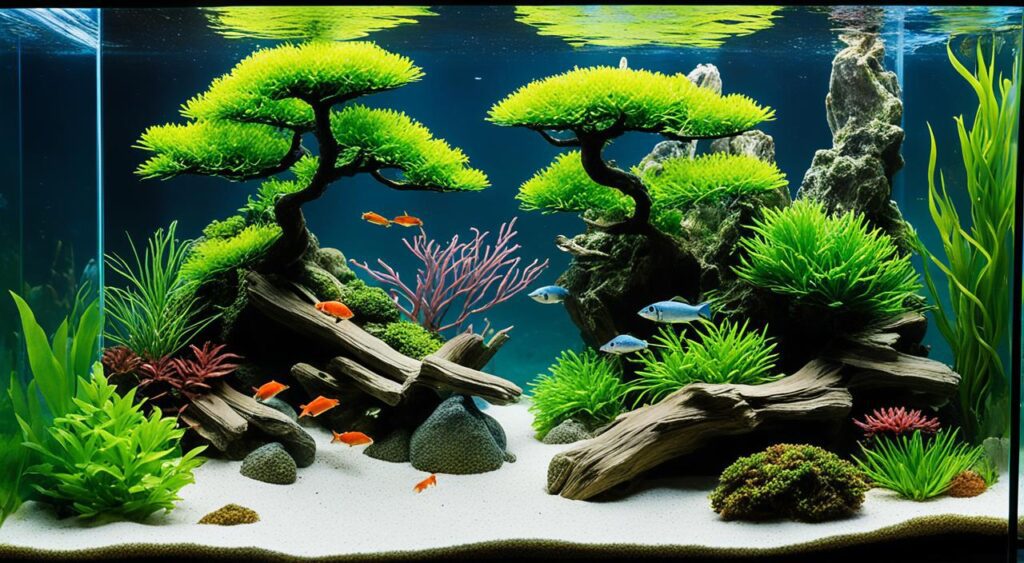
When it comes to aquascaping, there are various styles to choose from, each offering a unique aesthetic appeal. Whether you prefer a lush underwater forest or a minimalist landscape, finding the right aquascape style is key to creating a stunning underwater masterpiece. Let’s explore some of the popular aquascape styles:
Dutch Style: The Dutch style aquascape is known for its meticulous arrangement and cultivation of a wide variety of aquatic plants. With a focus on vibrant colors, textures, and leaf shapes, this style creates a visually stunning and vibrant underwater garden.
Jungle Style: Inspired by the dense growth of a natural forest, the Jungle style aquascape aims to recreate the untamed beauty of lush greenery. It showcases abundant plant growth, creating a wild and captivating underwater landscape.
Iwagumi Style: The Iwagumi style is characterized by a minimalist design that emphasizes the use of stones as the main focal point. It creates a serene and tranquil atmosphere, focusing on simplicity and balance.
Nature Aquarium Style: Developed by renowned aquascaper Takashi Amano, the Nature Aquarium style aims to recreate natural landscapes with a combination of plants, rocks, and wood. It seeks to evoke a sense of harmony, balance, and harmonious coexistence among aquatic organisms.
Seeking advice and inspiration from the aquascaping community is crucial for designing and maintaining your own aquascape. Valuable insights and tips from experienced aquascapers can help you refine your skills, experiment with different styles, and bring your creative vision to life.
| Aquascape Style | Characteristics |
|---|---|
| Dutch Style | Meticulous arrangement of a wide variety of aquatic plants |
| Jungle Style | Replicates the natural look of a dense forest with abundant plant growth |
| Iwagumi Style | Emphasizes minimalist design with stone as the main focal point |
| Nature Aquarium Style | Recreates natural landscapes with plants, rocks, and wood |
Equipment and Maintenance Tips
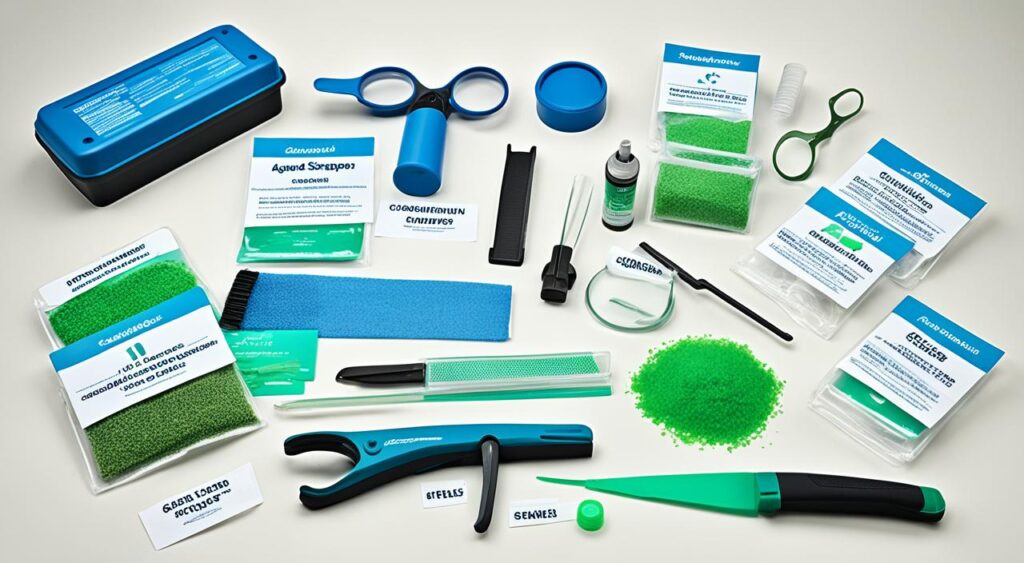
In addition to the basic components, there are several equipment and maintenance tips that can help in successful aquascaping. By utilizing these resources, following maintenance tips, and seeking community advice, you can ensure the health and longevity of your aquascape.
1. Algae Scrubber or Magnet
To keep the glass of your aquarium clean and free from algae buildup, consider using an algae scrubber or magnet. This handy tool makes it easy to remove algae without disturbing the plants and fish in your aquascape.
2. Proper Water Testing Kit
Monitoring water parameters is essential for maintaining a healthy aquatic environment. Investing in a reliable water testing kit will allow you to keep track of essential parameters like pH, ammonia, nitrate, and nitrite levels. Regular testing will help you identify any imbalances and take corrective measures promptly.
3. Siphon or Gravel Vacuum
Aquarium maintenance involves removing debris and waste from the substrate. A siphon or gravel vacuum is a valuable tool for this task. It allows you to efficiently clean the gravel or substrate without disturbing the plants and the overall layout of the aquascape.
4. Aquascaping Resources
When it comes to aquascaping, there are numerous resources available to learn from and gain inspiration. Online forums, blogs, and websites dedicated to aquascaping provide valuable tips, tutorials, and ideas to help you enhance your skills and design stunning aquascapes. Explore these resources to expand your knowledge and stay up-to-date with the latest trends.
5. Community Advice
The aquascaping community is known for its passionate and helpful members. Engaging with the community can provide valuable insights, advice, and feedback on your aquascape. Join online forums, social media groups, and local clubs to connect with fellow aquascapers and exchange ideas. Sharing experiences and learning from others’ successes and challenges can greatly enhance your aquascaping journey.
Remember, regular monitoring and maintenance are essential for the health and longevity of your aquascape. By utilizing recommended equipment, taking advantage of aquascaping resources, and seeking community advice, you can create and maintain a thriving underwater masterpiece.
Tips for Beginners
As a beginner in aquascaping, it’s crucial to start with a comprehensive checklist that outlines the necessary steps and components. This beginner’s guide will help you get started on your aquascaping journey and set you up for success. Here are some essential tips to keep in mind:
- Aquascaping Checklist: Begin by creating a checklist of the basic components and equipment you’ll need for your aquascape. This includes an aquarium, water filter, lighting system, CO2 system, substrate, and aquatic plants.
- Plant Selection: Carefully choose your aquatic plants based on their growth requirements and compatibility with the fish species you plan to keep. Research different plant species to find ones that are suitable for beginners and easy to maintain.
- Artistic Aquascaping: Seek inspiration from artistic aquascaping examples to develop your own unique style and design. Explore different aquascape styles like the Dutch style, Jungle style, Iwagumi style, and Nature Aquarium style. Pay attention to the placement of hardscape elements like rocks and wood, as well as the arrangement of plants to create visually appealing compositions.
- Patience and Commitment: Aquascaping requires patience and commitment. It takes time for plants to grow and for your aquascape to reach its full potential. Be prepared to invest time in maintenance tasks like pruning plants, monitoring water parameters, and conducting regular water changes.
By following these tips, you’ll be well on your way to creating a beautiful and thriving aquascape. Remember, aquascaping is an art form that allows you to bring nature into your home, so enjoy the process and let your creativity flourish.
Conclusion
Aquascaping is an art form that allows enthusiasts to create breathtaking underwater masterpieces right in their own homes. By following the aquascaping basics and utilizing the beginner’s guide, anyone can embark on this creative journey and transform their aquarium into a mesmerizing aquatic landscape.
By considering the basic components, such as the aquarium itself, filtration options, lighting requirements, CO2 system setup, substrate types, and aquatic plants, beginners can ensure a strong foundation for their aquascape. Implementing design principles and considering fish compatibility, nutrient dosing, and algae prevention techniques will help achieve a balanced and visually stunning aquascape.
With patience, commitment, and a willingness to learn, beginners can cultivate their skills and create underwater masterpieces that serve as a captivating focal point in any space. So dive into the world of aquascaping and unleash your creativity to bring the beauty of nature into your home.
FAQ
What is aquascaping?
Aquascaping is the art of building underwater landscapes in an aquarium by arranging stones, wood, and plants to create a miniature scene underwater.
What are the key components required for aquascaping?
The key components required for aquascaping include an aquarium, water filter, light source, CO2 system, substrate, and aquatic plants.
How do I set up the aquarium for aquascaping?
Setting up the aquarium involves considering water chemistry basics, establishing a maintenance routine, choosing suitable aquarium decorations and hardscape essentials, and utilizing aquascaping tools.
How can I achieve a balanced aquascape?
Achieving a balanced aquascape involves applying design principles, considering fish compatibility, nutrient dosing, and implementing algae prevention methods.
What are the different styles of aquascaping?
The different styles of aquascaping include the Dutch style, Jungle style, Iwagumi style, and Nature Aquarium style.
What are some equipment and maintenance tips for aquascaping?
Some equipment and maintenance tips for aquascaping include using algae scrubbers, having a water testing kit, using a siphon or gravel vacuum, and seeking advice from aquascaping resources and the community.
What are some tips for aquascaping beginners?
Some tips for aquascaping beginners include following a checklist, carefully selecting plants, and seeking inspiration from artistic aquascaping examples.
What is the essence of aquascaping?
Aquascaping offers a unique and visually appealing way to create underwater masterpieces in the form of aquarium landscapes, bringing nature’s beauty into homes.

